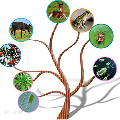Multimodal machine learning is a vibrant multi-disciplinary research field that aims to design computer agents with intelligent capabilities such as understanding, reasoning, and learning through integrating multiple communicative modalities, including linguistic, acoustic, visual, tactile, and physiological messages. With the recent interest in video understanding, embodied autonomous agents, text-to-image generation, and multisensor fusion in application domains such as healthcare and robotics, multimodal machine learning has brought unique computational and theoretical challenges to the machine learning community given the heterogeneity of data sources and the interconnections often found between modalities. However, the breadth of progress in multimodal research has made it difficult to identify the common themes and open questions in the field. By synthesizing a broad range of application domains and theoretical frameworks from both historical and recent perspectives, this paper is designed to provide an overview of the computational and theoretical foundations of multimodal machine learning. We start by defining three key principles of modality heterogeneity, connections, and interactions that have driven subsequent innovations, and propose a taxonomy of six core technical challenges: representation, alignment, reasoning, generation, transference, and quantification covering historical and recent trends. Recent technical achievements will be presented through the lens of this taxonomy, allowing researchers to understand the similarities and differences across new approaches. We end by motivating several open problems for future research as identified by our taxonomy.
翻译:多式机器学习是一个充满活力的多学科研究领域,目的是设计具有理解、推理和学习等智能能力的计算机代理,通过整合多种交流方式,包括语言、声学、视觉、触觉和生理信息,设计具有智能能力的计算机代理。由于最近对视频理解的兴趣,包括自主代理、文字到图像生成和多种感知整合应用领域,如保健和机器人等,多式机器学习给机器学习界带来了独特的计算和理论挑战。鉴于数据来源的不均匀性以及各种模式之间经常发现的相互联系,多式研究的广度使得难以确定该领域的共同主题和开放问题。通过从历史和最近的角度综合广泛的应用领域和理论框架,本文件旨在概述多式联运机学习的计算和理论基础。我们首先界定了三种主要模式的计算和理论原则,即驱动随后创新的多种创新,并提出六种核心技术挑战的分类:代表性、调整、推理、生成、转移性以及该领域的开放性问题。我们通过一系列技术研究、历史和最近的历史和历史趋势的量化方法,我们通过展示最新税收史的学习成就,将确定为新的历史和历史和历史趋势。




